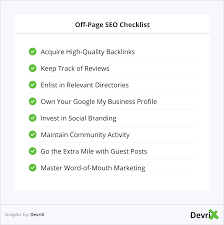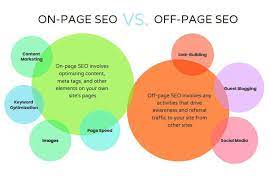Unlocking the Power of On-Page SEO: Boost Your Website’s Visibility and Performance
In the ever-expanding digital landscape, search engine optimization (SEO) has become an essential tool for businesses to enhance their online presence. While there are various aspects to SEO, on-page optimization plays a crucial role in improving your website’s visibility and performance. In this article, we will explore the power of on-page SEO and how it can benefit your online business.
On-page SEO refers to the practice of optimizing individual web pages to rank higher in search engine results pages (SERPs) and attract more organic traffic. Unlike off-page SEO, which focuses on external factors like backlinks and social media signals, on-page optimization revolves around optimizing content, HTML source code, and website structure.
One of the key elements of on-page SEO is keyword research. By identifying relevant keywords that align with your target audience’s search intent, you can strategically incorporate them into your website’s content. This helps search engines understand the relevance of your page to specific queries, increasing the chances of ranking higher in SERPs.
Another crucial aspect of on-page optimization is creating high-quality, engaging content. Search engines prioritize websites that provide valuable information and a positive user experience. By crafting well-written articles, blog posts, product descriptions, or landing page copy that address users’ needs and interests, you not only attract visitors but also encourage them to stay longer on your site.
Optimizing various HTML elements is also essential for effective on-page SEO. This includes crafting compelling meta titles and descriptions that accurately summarize each page’s content while enticing users to click through from SERPs. Additionally, optimizing header tags (H1-H6), URLs, image alt text, and internal linking structure helps search engines understand the context and relevance of your web pages.
Website performance is another critical factor in on-page optimization. Page loading speed significantly impacts user experience and search engine rankings. Optimizing images, leveraging browser caching, compressing files, and reducing unnecessary code can help improve your website’s loading time, ensuring that visitors have a seamless browsing experience.
Mobile optimization is no longer optional but a necessity in today’s mobile-first world. With the majority of internet users accessing websites through mobile devices, search engines prioritize mobile-friendly websites in their rankings. Ensuring responsive design, easy navigation, and fast loading speed on mobile devices is crucial for effective on-page SEO.
Regular monitoring and analysis of your website’s performance are vital to gauge the effectiveness of your on-page SEO efforts. Utilizing tools like Google Analytics and Search Console can provide valuable insights into user behavior, organic traffic trends, keyword rankings, and more. This data allows you to make informed decisions and continuously optimize your on-page SEO strategy.
In conclusion, on-page SEO is a powerful tool that can significantly impact your website’s visibility and performance in search engine results. By implementing effective keyword research, creating high-quality content, optimizing HTML elements, improving website performance, and prioritizing mobile optimization, you can enhance your online presence and attract valuable organic traffic. Remember to regularly monitor and analyze your efforts to stay ahead of the competition and continually improve your on-page SEO strategy.
5 Commonly Asked Questions about On-Page SEO in English (UK)
- What is onpage SEO and off-page SEO?
- What is on-page SEO checklist?
- What is on-page SEO and its types?
- What are on-page SEO techniques?
- What is on page SEO and off-page SEO?
What is onpage SEO and off-page SEO?
On-page SEO and off-page SEO are two essential components of search engine optimization, each focusing on different aspects of optimizing a website to improve its visibility and rankings in search engine results pages (SERPs).
On-page SEO refers to the practices and techniques implemented directly on a website to enhance its search engine rankings. It involves optimizing various elements within individual web pages, including content, HTML source code, website structure, and user experience. On-page SEO aims to make the website more relevant and valuable to both users and search engines.
Key elements of on-page SEO include:
Keyword research: Identifying relevant keywords that align with user search intent and incorporating them strategically into the website’s content.
Content optimization: Creating high-quality, engaging, and informative content that addresses users’ needs and interests while utilizing targeted keywords naturally.
HTML optimization: Optimizing HTML elements such as meta titles, meta descriptions, header tags (H1-H6), URLs, image alt text, and internal linking structure to provide context and relevance to search engines.
Website performance: Ensuring fast page loading speed by optimizing images, leveraging browser caching, compressing files, reducing unnecessary code, etc., to improve user experience.
Mobile optimization: Designing websites that are responsive and mobile-friendly for seamless browsing experiences on various devices.
On the other hand, off-page SEO focuses on activities performed outside of the website itself with the goal of improving its online reputation, authority, and visibility across the internet. Off-page SEO primarily revolves around building high-quality backlinks from other reputable websites as well as generating social signals through social media platforms.
Key elements of off-page SEO include:
Link building: Acquiring quality backlinks from authoritative websites through guest blogging, influencer outreach, directory submissions, social bookmarking sites, etc., which helps establish credibility and authority in the eyes of search engines.
Social media marketing: Promoting website content and engaging with the audience on various social media platforms to generate social signals, increase brand visibility, and drive traffic.
Online reputation management: Monitoring and managing online reviews, ratings, and mentions to maintain a positive brand image and reputation.
Brand mentions: Encouraging others to mention or link to your website naturally by providing valuable content or through public relations efforts.
Both on-page SEO and off-page SEO are crucial for a comprehensive SEO strategy. While on-page SEO focuses on optimizing the website’s internal elements to improve relevance and user experience, off-page SEO aims to build authority, credibility, and visibility across the internet through external factors like backlinks and social signals. A well-rounded approach that combines both aspects can significantly enhance a website’s visibility in search engine results.
What is on-page SEO checklist?
An on-page SEO checklist is a comprehensive list of tasks and best practices that you can follow to optimize individual web pages for search engines. By systematically going through this checklist, you can ensure that your web pages are properly optimized and have the best chances of ranking higher in search engine results. Here are some key elements typically included in an on-page SEO checklist:
- Keyword Research: Conduct thorough keyword research to identify relevant keywords that align with your target audience’s search intent.
- Title Tags: Craft unique and compelling title tags for each web page, incorporating the target keyword where appropriate.
- Meta Descriptions: Write concise and persuasive meta descriptions that accurately summarize the page’s content and entice users to click through from SERPs.
- Heading Tags: Use proper heading tags (H1-H6) to structure your content hierarchically, making it easier for search engines to understand the page’s organization.
- URL Structure: Create clean, descriptive, and user-friendly URLs that include relevant keywords.
- Content Optimization: Ensure your content is high-quality, engaging, and provides value to users. Incorporate target keywords naturally throughout the content while maintaining readability.
- Image Optimization: Optimize images by compressing them without compromising quality, using descriptive file names, and adding alt text with relevant keywords.
- Internal Linking: Include internal links within your content to provide additional context and guide users to related pages on your website.
- Mobile-Friendliness: Ensure your website is responsive and provides a seamless user experience on mobile devices.
- Page Loading Speed: Optimize page loading speed by compressing files, leveraging browser caching, minimizing unnecessary code, and optimizing images.
- Schema Markup: Implement structured data markup (schema.org) to provide additional information about your content to search engines.
- Social Sharing: Add social sharing buttons to encourage visitors to share your content on social media platforms.
- User Experience (UX): Focus on providing a positive user experience by ensuring easy navigation, clear and intuitive design, and fast loading times.
- Analytics and Monitoring: Set up analytics tools like Google Analytics to monitor website performance, track user behavior, and gain insights for further optimization.
- Regular Content Updates: Keep your content fresh and relevant by regularly updating it with new information or improvements.
Remember that search engine algorithms are constantly evolving, so it’s essential to stay updated with the latest best practices in on-page SEO. By following an on-page SEO checklist and continuously optimizing your web pages, you can improve your website’s visibility in search engine results and attract more organic traffic.
What is on-page SEO and its types?
On-page SEO refers to the practice of optimizing individual web pages to improve their visibility and ranking in search engine results pages (SERPs). It involves optimizing various elements on a webpage to make it more relevant, user-friendly, and search engine-friendly. Here are some key types of on-page SEO:
- Keyword Optimization: This involves conducting keyword research and strategically incorporating relevant keywords into your webpage’s content, meta titles, meta descriptions, headers, and URLs. Proper keyword usage helps search engines understand the relevance of your page to specific queries.
- Content Optimization: Creating high-quality, informative, and engaging content is crucial for on-page SEO. Optimizing your content involves ensuring it is well-written, structured with headings (H1-H6), and includes relevant keywords naturally throughout the text. Additionally, using descriptive and compelling meta titles and descriptions can attract more clicks from search engine users.
- HTML Tags Optimization: Optimizing HTML tags helps search engines understand the structure of your webpage better. This includes using proper header tags (H1-H6) to indicate the hierarchy of your content, optimizing image alt text for accessibility and keyword relevance, and creating descriptive title tags that accurately summarize the page’s content.
- URL Structure: Creating clean and descriptive URLs that include relevant keywords can make it easier for both users and search engines to understand what a page is about. Avoid using long strings of numbers or irrelevant characters in URLs.
- Internal Linking: Internal links connect different pages within your website, helping search engines discover new content while establishing a hierarchical structure for your site. By strategically linking related pages together using relevant anchor text, you can improve user navigation and distribute link equity throughout your website.
- Website Speed Optimization: Page loading speed is crucial for both user experience and search engine rankings. Optimizing images by compressing them without compromising quality, leveraging browser caching techniques, minifying CSS and JavaScript files, and reducing unnecessary code can help improve your website’s loading time.
- Mobile Optimization: With the increasing use of mobile devices, optimizing your website for mobile users is essential. Ensure your website has a responsive design that adapts to different screen sizes, provides easy navigation, and loads quickly on mobile devices.
These are just some of the key types of on-page SEO techniques. Implementing these strategies will help improve your website’s visibility, user experience, and search engine rankings. Remember to regularly monitor and analyze the performance of your on-page SEO efforts to make necessary adjustments and stay ahead in the competitive online landscape.
What are on-page SEO techniques?
On-page SEO techniques refer to the practices and strategies used to optimize individual web pages to improve their visibility and ranking in search engine results pages (SERPs). Here are some key on-page SEO techniques:
- Keyword Research: Conduct thorough keyword research to identify relevant keywords and phrases that align with your target audience’s search intent. Use tools like Google Keyword Planner or other keyword research tools to find high-volume, low-competition keywords.
- Optimized Content: Create high-quality, engaging content that incorporates your target keywords naturally. Ensure the content is well-structured, easy to read, and provides value to the users. Use proper headings (H1, H2, etc.) and include relevant keywords in the title, headings, meta tags, and throughout the content.
- Meta Tags Optimization: Optimize meta tags including the title tag (meta title) and meta description. The title tag should be concise, descriptive, and include relevant keywords. The meta description should provide a compelling summary of the page’s content while enticing users to click through from SERPs.
- URL Structure: Use clean and descriptive URLs that include relevant keywords related to the page’s content. Avoid using long strings of numbers or unnecessary parameters in URLs.
- Image Optimization: Optimize images by reducing file size without compromising quality for faster loading times. Use descriptive file names and add alt text that accurately describes each image using relevant keywords.
- Internal Linking: Incorporate internal links within your website’s content to guide users towards related pages or resources on your site. This helps search engines understand the structure of your website and improves user navigation.
- Mobile Optimization: Ensure your website is mobile-friendly by implementing responsive design principles that adapt to different screen sizes seamlessly. Mobile optimization is crucial as search engines prioritize mobile-friendly websites in their rankings due to the increasing number of mobile users.
- Page Speed Optimization: Improve page loading speed by optimizing images, leveraging browser caching, minifying CSS and JavaScript files, and reducing unnecessary code. A fast-loading website enhances user experience and improves search engine rankings.
- User Experience (UX): Focus on providing a positive user experience by ensuring easy navigation, clear site structure, and intuitive design. Optimize for readability with proper formatting, headings, bullet points, and relevant multimedia elements.
- Schema Markup: Implement structured data markup (schema markup) to provide additional information about your website’s content to search engines. This can enhance the visibility of your pages in SERPs by displaying rich snippets or other enhanced search results.
Remember, on-page SEO techniques should be implemented in a natural and user-friendly manner. Strive to create valuable content that addresses users’ needs while optimizing it for search engines to improve your website’s visibility and organic traffic.
What is on page SEO and off-page SEO?
On-page SEO and off-page SEO are two key components of search engine optimization, each focusing on different aspects of optimizing a website to improve its visibility in search engine results pages (SERPs).
On-page SEO refers to the practices and techniques that are implemented directly on the website itself to optimize its individual web pages. It involves optimizing various elements within the website, including content, HTML source code, and website structure. The primary goal of on-page SEO is to make the website more search engine-friendly and user-friendly, ensuring that it provides valuable information and a positive user experience. Some common on-page SEO techniques include keyword research and optimization, creating high-quality content, optimizing meta titles and descriptions, using header tags effectively, improving page loading speed, implementing mobile optimization, and optimizing internal linking structure.
Off-page SEO, on the other hand, focuses on external factors that can influence a website’s visibility in search engines. It involves actions taken outside of the website itself to improve its online reputation and authority. The primary goal of off-page SEO is to increase the website’s popularity and credibility across the web. This is primarily achieved through building high-quality backlinks from other reputable websites. Backlinks act as votes of confidence from other sites, indicating to search engines that your website is trustworthy and relevant. Other off-page SEO techniques may include social media marketing, influencer outreach, guest blogging, online reputation management, and brand building.
Both on-page SEO and off-page SEO are crucial for achieving optimal search engine rankings. While on-page SEO ensures that your website is technically optimized for search engines and provides valuable content for users, off-page SEO helps establish your website’s authority and reputation across the web. A comprehensive approach that combines both strategies can significantly enhance your website’s visibility in SERPs and drive organic traffic to your site.




